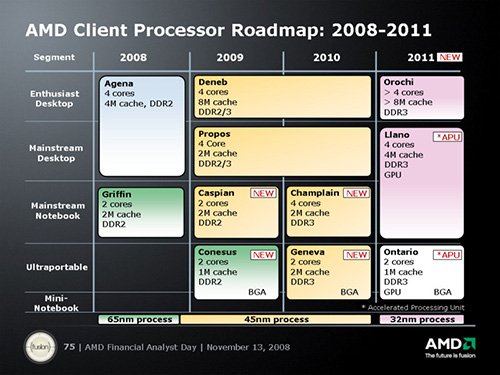
AMD started talking about a processor with integrated GPU when it bought ATI in 2006, and last year the firm told analysts it would launch a Fusion-based notebook platform in 2009, this platform would be called Shrike and would feature the Swift "Fusion" processor. These plans have been cancelled and it seems Intel will beat AMD to it by a large margin as Intel Havendale processors with integrated GPU are expected to arrive in the second half of 2009.
The roadmap unveils AMD will roll out 45nm processors for all consumer segments in 2009, with a refresh planned for 2010. Next year we can expect the quad-core Deneb for the enthusiast desktop market, the quad-core Propos for the mainstream desktop market, dual-core Caspain for the mainstream notebook market and dual-core Conesus for ultraportable/mini-notebook market. A year later, AMD plans to introduce the quad-core Champlain for the mainstream notebook market and a new dual-core for the ultraportable/mini-notebook market.
The first 32nm processors will be rolled out in 2011. For the enthusiast desktop market this will be a Orochi chip with more than four cores, mainstream desktop and notebook users will get the quad-core Liano and for the ultraportable/mini-notebook market the firm is cooking up the dual-core Ontario. The latter two chips will be the first AMD Fusion processors. No changes are planned for the server market.
According to AMD, the real sweet spot for "accelerated processing units" that couple GPU and CPU cores will be at the 32nm node, where it expects to deliver optimal performance per watt. In the meantime, the company has four new mobile CPUs in the pipeline.
The first two of those chips, Conensus and Caspian, will both come out next year and feature two cores and DDR2 memory support. The former will debut in the second half of 2009 in a new Yukon platform aimed at ultra-portable notebooks and "mini-notebooks," while the Caspian-powered Tigris platform will follow in the second half of the year and target mainstream laptops.
AMD will follow up in 2010 with Geneva and Champlain. Both CPUs will support DDR3 memory, and Champlain will deliver four processing cores to mainstream notebooks. Like Conesus, Geneva will hit ultraportables and mini-notebooks in a ball-grid-array package, meaning it should be soldered directly onto system boards. Since both Conesus and Geneva will feature two cores and slip into ultraportables, AMD may be targeting them at Intel's ultra-low-voltage Core 2 processors rather than Atom-based systems.
AMD has also given the public the first glimpse of its 32nm roadmap. The new Bulldozer architecture will finally hit desktops in 2011 with Orochi, a 32nm enthusiast CPU with more than four cores, over 8MB of cache, and DDR3 memory support. AMD talked about Bulldozer in the summer of 2007, saying it would see the light of day in 2009 as part of Falcon GPU-CPU chimeras and Sandtiger server processors with up to 16 cores. The architecture mysteriously disappeared from subsequent roadmaps, though, and our queries about it were left unanswered.

Source: The Tech Report.